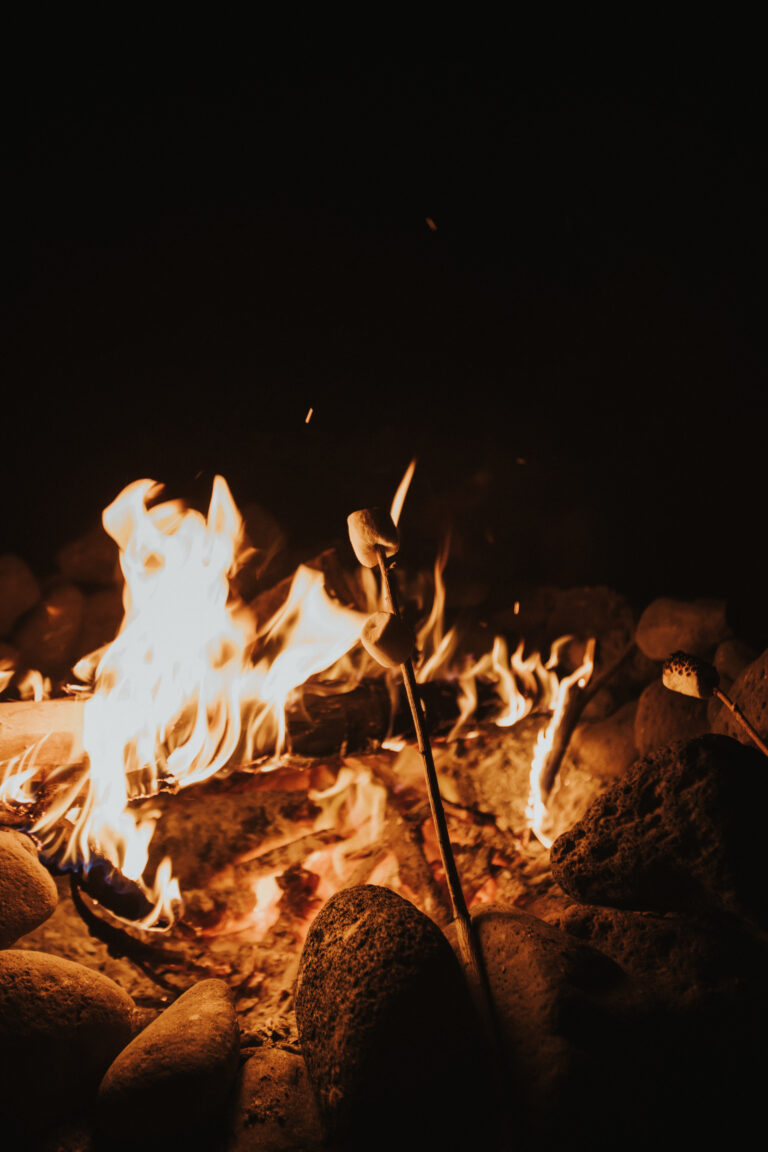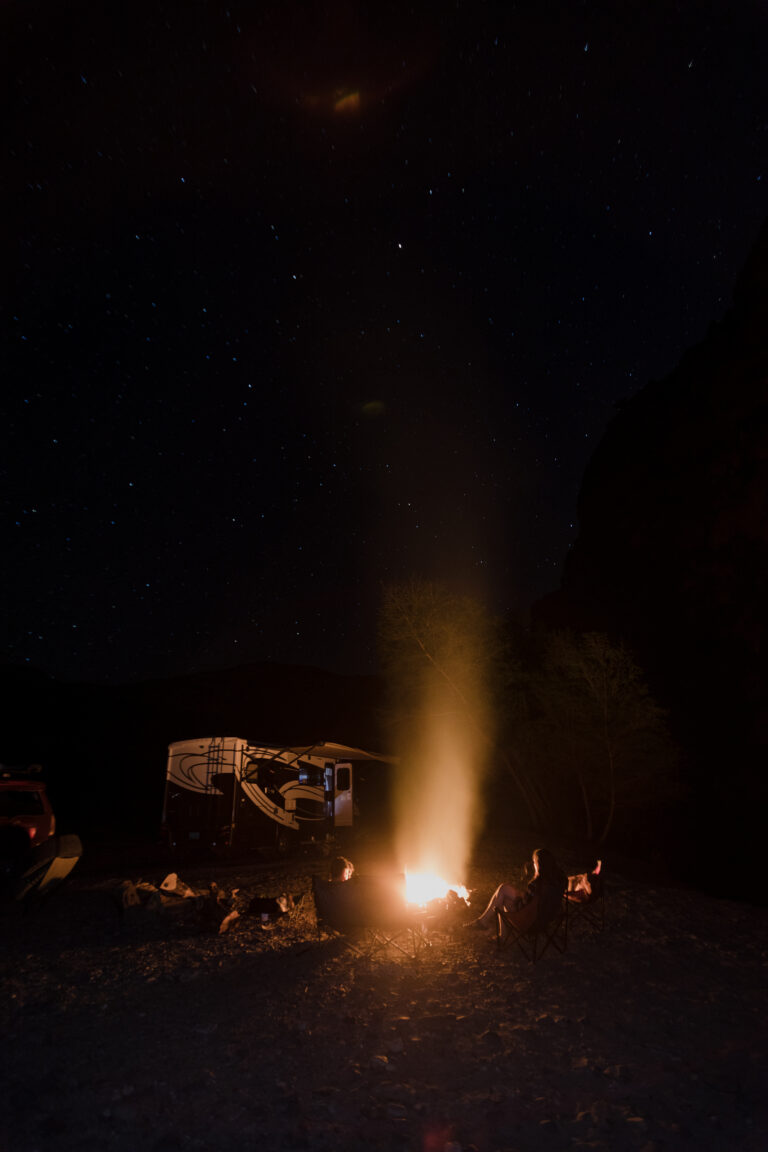
Face it: Campfires are probably about 80% of the reason you were drawn to camping in the first place.
It might seem simple, but there’s just something about them. First, the ritual of slowly building a roaring fire from a few lowly sparks, lovingly arranging kindling, and gently blowing the glowing embers to life. Then, the excitement of gathering the family around your now-raging campfire, getting ready for a night filled with sharing — of both stories and s’mores.
Even the careful steps you take to ensure the fire’s good and out at the end of the night play a part in the romance.
But campfires are, of course, inherently dangerous. We’re talking about fire, after all! And that means you need to respect certain guidelines whenever you build one near your campsite. That way, your campfire will remain a whimsical centerpiece to your journey… rather than the epicenter of some disaster that ruins your trip.
So what, exactly, are the rules of campfire safety? Heck, how do you build one in the first place?
We put together this campfire construction and safety guide to help you enjoy your nights gathered around the flames without putting anyone in danger.
Basic Campfire Safety
The most basic steps toward campfire building safety are actually very easy to follow. The biggest one is simply to always build your fire in a pre-constructed campfire ring or fire pit. By doing this, not only will you avoid the possibility of the fire spreading somewhere unexpected, but you’ll also avoid burning — and thus destroying — a new piece of natural land.
If there’s not a campfire ring already created on your campsite, you can construct one yourself, although it’s always better to seek out a spot where a fire has already been made.
To create your own fire pit, you’ll need to start by thoroughly clearing the area of any plants, twigs, grass, leaves, and other debris that could burn uncontrollably once you start your fire. You’ll want to ensure you leave a decent amount of extra space around the outside perimeter of where you’re planning to build the fire itself. That crackling sound we all love so much can actually result in tiny embers flying as far as 15 feet off the fire… so make sure there’s nothing flammable close by!
Once you’ve got a good stretch of clean, open land to build a fire on, you can begin to construct the outside of the ring with rocks. You’ll likely want to aim to build a ring about 2 to 5 feet in diameter, being sure to leave a little bit of space between where the edge of the fire will be and the rocks themselves.
Then, you can surround your ring with seating — either foldable camping chairs you’ve brought along or natural alternatives like tree stumps and flat rocks.
Now that you have a fire pit, what are some other important tips on campfire safety to follow?

Campfire Safety Precautions
Most of the safety rules for using a campfire are fairly common sense, but it’s still a good idea to refer to them if you’re a new camper — or even if you’re an old hat with some doubts.
First of all, you always want to make sure your campfire is a fair distance away from your RV. After all, you have lots of flammable stuff on board, including tanks of fuel and liquid propane. If you build your campfire too close, you risk a serious fire or even an explosion.
Another of our favorite campfire safety tips is always to keep fire safety equipment close at hand. Your rig likely comes equipped with a fire extinguisher (which you should always ensure is up to date and ready!), so go ahead and grab it before you get your campfire going. It’s a simple thing, but it can really bring you a lot of peace of mind.
Finally, if you’re going to use a fire starter — like lighter fluid — to hasten the growth of your campfire, make sure you use it carefully and don’t use too much. Those liquids are incredibly flammable… which is, of course, the whole point. But it can also be a dangerous game to soak all your kindling in such a quick-burning substance, or worse, get it on yourself.
Campfire Safety for Kids
If you’ve got kids along for the ride, campfire safety becomes even more important. But campfire rules for kids are also pretty simple to follow.
Obviously, children should never be left unsupervised near an active campfire, and they shouldn’t be allowed to get too close to one, either. By teaching children to respect fire, you’ll help them enjoy safe camping trips in the future when they’re the ones in charge of building the flames!
Building a Campfire
So now that we’ve talked about staying safe with your campfire, let’s talk about construction. How do you build a great campfire? What are the different types? Is there a specific way to build a campfire for cooking?
In many families, campfire-building techniques are time-honored and sacred steps, passed down over generations. Maybe one of your uncles was a Boy Scout and has very specific — and “official” — ideas about how a campfire is built.
But at the end of the day, the best way to build a campfire is whatever way works for you. Obviously, you need some dry kindling, and once you have enough to create a small spark, you need to provide larger logs for fuel to keep the fire burning as long as you’d like. Some campers use artificial fire starters or lighter fluid, while for others, that would be sacrilege. But any way you get there, the campfire itself will burn whatever wood or other fuel you make available!
No matter what kind of campfire you create or how you build it, don’t forget the most important campfire safety rule of all: Always ensure your campfire is thoroughly, 100% out before you leave it unattended or head in for a night’s sleep.
Enjoy your trip — and your time connecting with your loved ones over an open flame.

